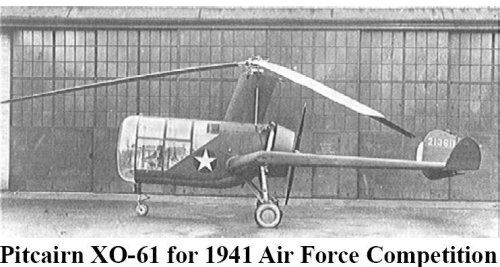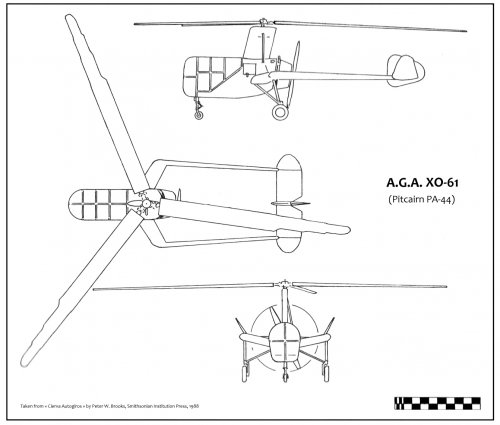You are using an out of date browser. It may not display this or other websites correctly.
You should upgrade or use an alternative browser.
You should upgrade or use an alternative browser.
Pitcairn XO-61 twin boom observation aircraft
- Thread starter hesham
- Start date
- Joined
- 25 June 2009
- Messages
- 13,941
- Reaction score
- 3,574
AeroFranz said:That NASA report is pretty good, lots of interesting stuff.
Hesham, thanks for posting this. i had heard of the XO-61 but had never been able to find a picture.
I don't think I ever saw another picture of that bird... Until that happens, here's a beautiful three-view plan for your enjoyment.
Please note the chronology:
1°) The design was submitted by Pitcairn at a time when the company was operating as the Pitcairn-Larsen Autogiro Company (circa late 1940).
2°) The aircraft was ordered in 1941 by U.S.A.A.F. from the A.G.A. Aviation Corporation, a company which had since taken over the activities of the former Pitcairn Autogiro Company.
3°) The A.G.A. Aviation Corporation became the G & A Aircraft Inc. division of the Firestone Tire and Rubber Company in 1943.
Attachments
Jos Heyman
ACCESS: Top Secret
- Joined
- 15 February 2007
- Messages
- 597
- Reaction score
- 62
Originally designed by Pitcairn, which company was taken over by AGA Aviation in December 1941, six XO-61 autogyros were ordered but were subsequently cancelled. The serials were 42-13611/13616. Five were to have been converted with a Jacobs-R 915-3 engine and redesignated as YO-61.
The photograph is evidence of at least one having been completed.
Specifications:
rdm.: 48', 14.63 m
length: 28'6", 8.69 m
engines: 1 Jacobs R-755-1
max. speed: 103 mph, 166 km/h
The photograph is evidence of at least one having been completed.
Specifications:
rdm.: 48', 14.63 m
length: 28'6", 8.69 m
engines: 1 Jacobs R-755-1
max. speed: 103 mph, 166 km/h
- Joined
- 25 June 2009
- Messages
- 13,941
- Reaction score
- 3,574
The information I have about the XO-61 is mostly the same, except for the engine type:
Overall length: 28 ft 6 in (8.68 m)
Maximum take-off weight: 3,000-3,038 lb (1,360-1,378 kg)
Maximum speed: 103 mph (165 km/h)
Minimum speed: 29 mph (46 km/h)
Engine:
The 300-325 hp Jacobs R-915A3 (or R-915A-4) engine drove a constant-speed propeller, having a special low-pitch setting for rotor spin-up purposes. This was similar to the PA-39 and had originally been proposed by Paul Stanley when commenting on proposals for jump take-off put forward by Richard Prewitt in 1932.
Rotor diameter and blade section:
The XO-61 was originally designed with a 42 ft (12.8 m) rotor of NACA 230 series section. This was later increased in diameter to 48 ft (14.63 m).
Production:
In addition to one static test airframe, six (later reduced to one (42-13611)), of the type were originally ordered as XO-61, of which five (42-13612/13616) were to be supplied in YO-61 service test form. However, only two aircraft were completed—the first in the spring of 1943—and these were never submitted to the army for acceptance because the contract was canceled before testing had been completed. The cancellation occurred when the second aircraft had reached the flying stage. Neither went into service because of engineering problems (including ground resonance, said to be due to defective shock absorbers, and engine cooling difficulties); manufacturing delays (G. and A. Aircraft were preoccupied with their involvement in the Waco CG-4A Hadrian troop-carrying glider program); and the appearance of the first production helicopters, in the form of the Sikorsky R-4, which entered service early in 1944.
Comment:
The YO-61 represented almost the ultimate in development of the Autogiro concept as it had evolved over the preceeding twenty years. Cancellation of the YO-61 order finally terminated American Autogiro manufacture. Pitcairn had by then built rather more than a hundred Autogiros. Of this number, about twenty were rebuilt from earlier models, as if they were new. Harold Pitcairn progressively withdrew from his aviation interests at this time. However, from 1951 until his death in 1960, he found himself deeply involved in the rotary-wings patents lawsuit against the United States government. He died, accidentally, from a gunshot wound, seventeen years before the lawsuit was finally settled in his favor.
Source: Peter W. Brooks, Cierva Autogiros - The Development of the Rotary-Wing Flight, Smithsonian Institution Press, 1988
Overall length: 28 ft 6 in (8.68 m)
Maximum take-off weight: 3,000-3,038 lb (1,360-1,378 kg)
Maximum speed: 103 mph (165 km/h)
Minimum speed: 29 mph (46 km/h)
Engine:
The 300-325 hp Jacobs R-915A3 (or R-915A-4) engine drove a constant-speed propeller, having a special low-pitch setting for rotor spin-up purposes. This was similar to the PA-39 and had originally been proposed by Paul Stanley when commenting on proposals for jump take-off put forward by Richard Prewitt in 1932.
Rotor diameter and blade section:
The XO-61 was originally designed with a 42 ft (12.8 m) rotor of NACA 230 series section. This was later increased in diameter to 48 ft (14.63 m).
Production:
In addition to one static test airframe, six (later reduced to one (42-13611)), of the type were originally ordered as XO-61, of which five (42-13612/13616) were to be supplied in YO-61 service test form. However, only two aircraft were completed—the first in the spring of 1943—and these were never submitted to the army for acceptance because the contract was canceled before testing had been completed. The cancellation occurred when the second aircraft had reached the flying stage. Neither went into service because of engineering problems (including ground resonance, said to be due to defective shock absorbers, and engine cooling difficulties); manufacturing delays (G. and A. Aircraft were preoccupied with their involvement in the Waco CG-4A Hadrian troop-carrying glider program); and the appearance of the first production helicopters, in the form of the Sikorsky R-4, which entered service early in 1944.
Comment:
The YO-61 represented almost the ultimate in development of the Autogiro concept as it had evolved over the preceeding twenty years. Cancellation of the YO-61 order finally terminated American Autogiro manufacture. Pitcairn had by then built rather more than a hundred Autogiros. Of this number, about twenty were rebuilt from earlier models, as if they were new. Harold Pitcairn progressively withdrew from his aviation interests at this time. However, from 1951 until his death in 1960, he found himself deeply involved in the rotary-wings patents lawsuit against the United States government. He died, accidentally, from a gunshot wound, seventeen years before the lawsuit was finally settled in his favor.
Source: Peter W. Brooks, Cierva Autogiros - The Development of the Rotary-Wing Flight, Smithsonian Institution Press, 1988
Similar threads
-
-
NASA Advanced Control Technology for future transport (1976)
- Started by hesham
- Replies: 0
-
-
-


